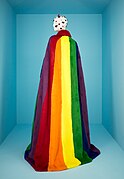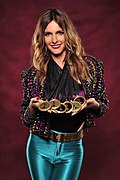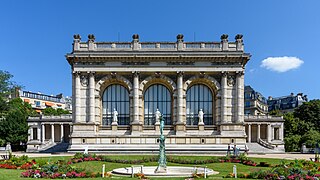The Fashion Portal
 | |

| |
Fashion is a term used interchangeably to describe the creation of clothing, footwear, accessories, cosmetics, and jewellery of different cultural aesthetics and their mix and match into outfits that depict distinctive ways of dressing (styles and trends) as signifiers of social status, self-expression, and group belonging. As a multifaceted term, fashion describes an industry, styles, aesthetics, and trends.
The term 'fashion' originates from the Latin word 'Facere,' which means 'to make,' and describes the manufacturing, mixing, and wearing of outfits adorned with specific cultural aesthetics, patterns, motifs, shapes, and cuts, allowing people to showcase their group belonging, values, meanings, beliefs, and ways of life. Given the rise in mass production of commodities and clothing at lower prices and global reach, reducing fashion's environmental impact and improving sustainability has become an urgent issue among politicians, brands, and consumers. (Full article...)
Selected article -
Fashion is a 2008 Indian Hindi-language drama film directed and co-produced by Madhur Bhandarkar starring Priyanka Chopra, Kangana Ranaut and Mugdha Godse in lead roles, and Arjan Bajwa, Samir Soni and Arbaaz Khan in supporting roles. The film's screenplay was co-written by Ajay Monga, Bhandarkar and Anuraadha Tewari and principal photography occurred in Mumbai and Chandigarh. Its music was composed by Salim–Sulaiman and the songs' lyrics were written by Irfan Siddiqui and Sandeep Nath. Development of the film began in 2006 with a budget of ₹180 million (US$2.2 million).
The story revolves around Meghna Mathur, an aspiring fashion model; it follows her transformation from small-town girl to supermodel, the Indian fashion industry and the careers of several other models. Fashion also explores feminism and female power in Indian fashion. The cast also features several professional fashion models playing themselves. The film was a turning point in Chopra's career after several consecutive flops prior to this film. (Full article...)Core topics -
The study of the history of clothing and textiles traces the development, use, and availability of clothing and textiles over human history. Clothing and textiles reflect the materials and technologies available in different civilizations at different times. The variety and distribution of clothing and textiles within a society reveal social customs and culture.
The wearing of clothing is exclusively a human characteristic and is a feature of most human societies. There has always been some disagreement among scientists on when humans began wearing clothes, but newer studies from The University of Florida involving the evolution of body lice suggest it started sometime around 170,000 years ago. The results of the UF study show humans started wearing clothes, a technology which allowed them to successfully migrate out of Africa. Anthropologists believe that animal skins and vegetation were adapted into coverings as protection from cold, heat, and rain, especially as humans migrated to new climates. (Full article...)Featured picture -

American folk singers Joan Baez and Bob Dylan, performing a duet at the March on Washington for Jobs and Freedom on August 28, 1963. Both were relatively new recording artists at the time, with Baez being at the forefront of American roots revival and Dylan having just released his second album. Baez was especially influential in introducing audiences to Dylan's music by recording several of his early songs and inviting him onstage during her own concerts.
Did you know... -
- ... that the pink dress (pictured) which Marilyn Monroe wore in Gentlemen Prefer Blondes (1953) was emulated by Madonna in her video to "Material Girl"?
- ... that fashion model Frankie Rayder has posed with her sisters Molly and Missy for Gap holiday ads?
- ... that Nonnie Moore, a woman who had been fashion editor at Mademoiselle and Harper's Bazaar, was hired by GQ in 1984 in a move that was called "an odd choice, but... was actually the perfect choice"?
Selected biography -
Joanne Gair (born c. 1958), nicknamed Kiwi Jo (alternatively Kiwi Joe), is a New Zealand-born and -raised make-up artist and body painter whose body paintings have been featured in the Sports Illustrated Swimsuit Issue from 1999 to 2017. She is considered the world's leading trompe-l'œil body painter and make-up artist, and she became famous with a Vanity Fair Demi's Birthday Suit cover of Demi Moore in a body painting in 1992. Her Disappearing Model was featured on the highest-rated episode of Ripley's Believe It or Not. She is the daughter of George Gair.
In addition to achieving pop culture prominence and respect in the fashion and art worlds starting with her body painting of Demi Moore, she is a make-up artist in the rock and roll world who has helped several of her music clients win fashion and style awards. She is also considered a fashion and art trendsetter, and for a long time she was associated with Madonna. In 2001, she had her first retrospective and in 2005, she published her first book on body painting. At the peak of her pop culture fame after the Vanity Fair cover, she was seriously considered for an Absolut Vodka Absolute Gair ad campaign. She has done magazine editorial work, and in 2005, she became a photographer of her own body paintings in both books and magazines. (Full article...)General images
Lua error: No content found on page "Women's beachwear fashion".
More Did you know (auto generated)

- ... that Malika Louback believes her three engineering degrees make her a better fashion model?
- ... that much of the research in dress history has been done from documents, illustrations, and photographs rather than by studying items of clothing?
- ... that Shushu/Tong is a brand that creates fashion collections inspired by magical girl anime such as Puella Magi Madoka Magica?
- ... that when the Hungarian Arts Fund denied a grant application by Tamás Király for a fashion show, he used the rejection letter as a poster?
- ... that fashion model Vivienne Rohner, named after fashion designer Vivienne Westwood, opened one of Westwood's shows during her first season as a model?
- ... that the Alexander McQueen collection Neptune drew negative reviews comparing the clothing to 1980s science fiction, Xena, and Wonder Woman?
Selected quote -
Related portals
Topics
Featured content
Categories
Things you can do
- Fill out the red links on Portal:Fashion/Selected anniversaries
Wikimedia
The following Wikimedia Foundation sister projects provide more on this subject:
-
Commons
Free media repository -
Wikibooks
Free textbooks and manuals -
Wikidata
Free knowledge base -
Wikinews
Free-content news -
Wikiquote
Collection of quotations -
Wikisource
Free-content library -
Wikiversity
Free learning tools -
Wiktionary
Dictionary and thesaurus


































